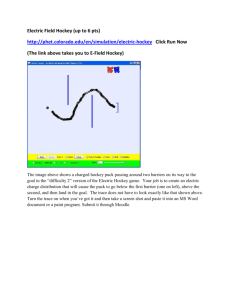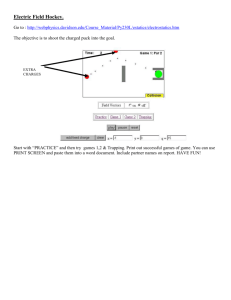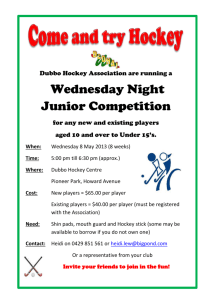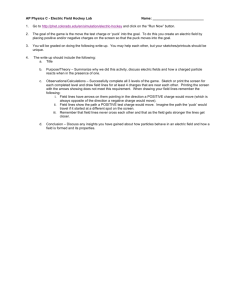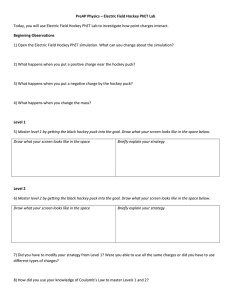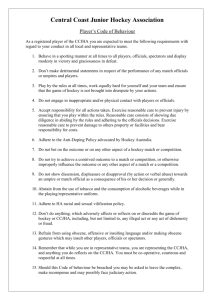Cross Ice
advertisement
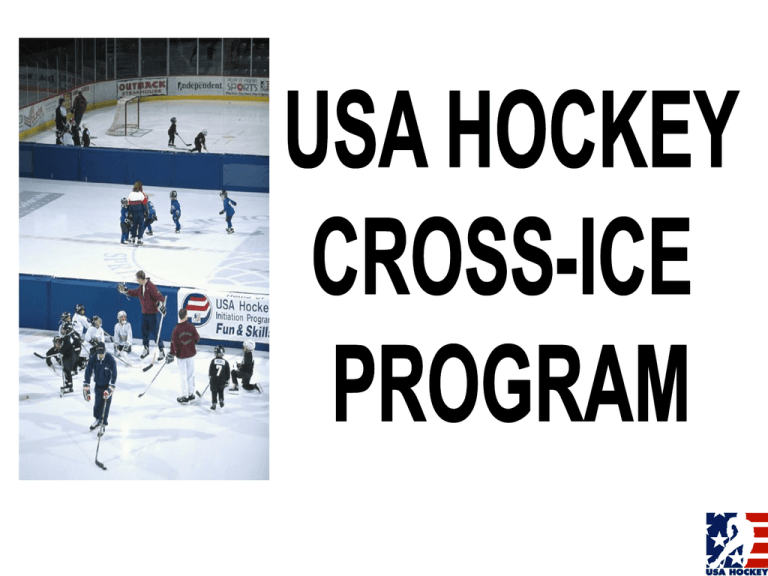
“75% OF ALL YOUNGSTERS DROP OUT OF YOUTH SPORTS BY AGE 13!” * IT’S NOT FUN * TOO MUCH PRESSURE Who’s The Most Competitive? • Parents 79% • Coaches 17 % • Kids 4% Parenting Magazine Poll - “Sportsmanship 101 - for Parents” Remember “As coaches we need to remember that a child’s most important work is to play. Not to be an investment for a college hockey scholarship or a professional contract or to further our egos by the success that our teams have, but to play for the simple love of playing. Learning and development, more often than not, involve mistakes and failure. We cannot be afraid to allow our children to experience these emotions as they are a natural part of the human experience. Very few of us learned to walk without crawling or learned to ride a bicycle without falling. It’s a natural progression and evolution.” Chris Bonnell – ACE Coordinator, Minnesota Hockey * USA HOCKEY encourages an environment in which children can learn the basic skills without the distractions that are often associated with an over emphasis on winning. * Mastery of fundamental skills and the fun of playing are essential to the development of a LIFELONG interest in hockey. * Programs must be conducted to accommodate the number of new players who wish to play hockey, and reduce the number who become disenchanted and drop out. • Stress participation, fun and skill development. • Modify the playing environment to meet the needs of young players. • Increase opportunities for players to touch and handle the puck. • Increase the practice to game ratio to a minimum of three practices to each game. • Improve the utilization of ice time. • Provide a positive environment for learning the fundamental skills of hockey. • Cross Ice Program “teams” should have approximately 10 to 12 players…encourage different players to play goalie. • Practices and games should be conducted “cross-ice.” • The ice should be divided into thirds – with the rink dividers across each blue line. • The lightweight blue puck should be used for all games and practices. • A practice to game ratio of 3 practices to each game is highly recommended. • Players should have the opportunity to “scrimmage” every practice. Suggested Practice Structure * 5 minute fun warm-up games (tag, keep away, etc.) * 30 - 45 minute individual skills to include skating, stick handling, passing and shooting drills and games…small area games are recommended…each drill should be followed-up with a game that stresses the skill just practiced. * 10 - 15 minute ‘pond hockey’ / scrimmages. * Practices can include up to six teams – two teams in each section of the ice. (Approx. 60 – 70 players) * All practices should be up beat, high energy and most importantly FUN. It’s important that the players leave the rink each day with a smile on their face. Making the PRACTICES FUN and ACCENTUATING FUN GAMES is your most important task!! It doesn’t mean in any way that the players do as they please. Order and method are an important ingredient even when you have fun. It does not matter that the drills are simple, only that the players have fun and at the same time feel that they have learned something. It is about getting to play a lot, often in small games, and that you pay attention and encourage each child in each practice. SUGGESTED GAME STRUCTURE •Associations are encouraged to be creative with the “game days.” (Game day could include playing multiple teams within the time slot – ‘jamborees’.) • No score shall be kept for games - the scoreboard shall be used as a timing device only – the horn shall sound every 90 seconds for a player change. • ONE coach or referee should be utilized to officiate each zone. • Face-offs should be conducted in the middle of the ice section; to begin games, after every goal, after every penalty substitution. • Penalties – flagrant injury type penalties should be whistled. A penalized player’s team will not play short-handed. Penalized players should be immediately substituted and miss the remainder of that shift. • Teams shall play a maximum of 25 ‘game days’ or ‘jamborees’ – this would require a minimum of 75 practices. Scoring records, statistics and records should NOT be kept. COACHES ROLE Your impression upon these youngsters is profound. How they relate to the game of hockey depends upon YOU. Your role is vital and heavy with responsibility. • Provide positive reinforcement; build confidence. • Emphasize skill development – skating, stick skills and a sense for the game. • Instill a passion for the game in your players. • Play within the rules…respect the game. • Make hockey FUN! Give a lot of praise and encouragement so that everybody gains confidence when they are successful!! • More Puck Contact…Resulting in Improved Puck Skills • More Shooting Opportunities…Enhances Scoring Skills • More Repetitions for Goalies • Smaller Playing Surface Results in Increased Tempo, Quicker Decisions and Quicker Reactions • Hockey Sense is Developed at a Younger Age • More Efficient Use of Ice Time…Allows for More Practice or Lower Cost SKILLS “Hockey Is Not Rocket Science. It’s Not All X’s and O’s and Positioning and Systems. The Team With The Best Skills Are Usually Going To Win.” Don Lucia, Head Coach at the University of Minnesota, NCAA 2002 and 2003 National Champions FUNDAMENTALS “We have a 12-year limit in Russia. This is good. Before 12, you should only practice fundamentals, skating, passing and shooting. It only takes two seconds to learn how to be a good body checker.” Rafael Ishmatov, Head Coach of the 2003 Gold Medal winning Russian National Junior Team “The younger kids Play to Learn. The older kids Learn to Play” Tomas Percic, Professor of Ice Hockey at the University of Prague 2002 Puck Possession Studies Olympics 12U 14U 17U No. of Shifts Playing Time Puck Touches Pass attempts Passes rcvd Shots attempted Possession Time 23.65 18:46 44 23 21 4 1:07 21 19 19 16:02 18:06 17:13 32 43 39 12 18 16 10 13 12 5 5 5 38.4 1:06 48.3 OBSERVATION EXCERCISE Date of Observation:___________________ Name of Observer:_____________________ Team:_______________________________ Player Observed:_____________________ Number of Shifts:_____________________ Playing Time:________________________ Number of Puck Touches:______________ Number of Passes Attempted:___________ Number of Passes Received:____________ Number of Shots:______________________ Total Puck Possession Time:_____________ Cross-Ice Equipment Suppliers Athletica Rink Dividers (Border Patrol) 952-915-4226 The light-weight blue puck is available at Play-itAgain-Sports, most pro shops and online at www.usahockey.com. For a detailed packet about the Cross-Ice Program, please contact the Youth Hockey Department at USA Hockey. 1-800-566-3288 “If you want only to win the next game, it is unlikely you will win the last game” Jukka Jolanen
